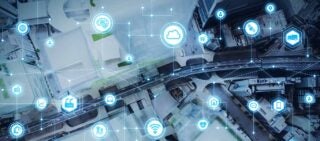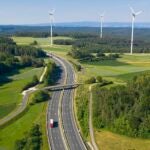- Resources
- Cities are growing faster and smarter, but can they go greener? We asked Siemens.
Resources
Cities are growing faster and smarter, but can they go greener? We asked Siemens.
Published: July 31, 2019 by EDF Staff
When you think about Siemens, you’re probably picturing medical scanners, energy generators, or transportation equipment. You might not be thinking about smart cities, or how the company is working to accelerate technology innovation, eMobility, resilience, and urban sustainability. But that’s just what Martin Powell, the Global Head of Urban Development at Siemens, focuses on each and every day.
As air pollution and climate change pose unprecedented threats to cities across the globe, it’s more important than ever to transform the way that urban areas operate. I recently caught up with Martin to learn about how cities are using next-generation technologies to advance climate goals, what else companies and cities can be doing, and his personal connection to air pollution.
Here is an edited version of our transcript.
What exactly is a “smart city”?
A smart city optimizes and improves its infrastructure through connectivity between the unique underlying systems that support it, in order to improve quality of life for residents economically, environmentally, and socially.
For a smart city to succeed, we need good data to understand how to optimize infrastructure performance. The data then needs to be visually accessible for decision makers which helps them to identify policies for improving access to clean water, reducing toxic air, or reducing emissions from traffic.
One example of applying data for better policies is low emission zones (LEZ) for schools. By applying LEZs on the worst pollution days, we can ensure that kids get to and from school safely without exposure to harmful pollutants. It’s very easy for a city to connect sensors together and consider policies to control this issue.
It’s also exciting how much has transformed in the Smart Cities space in just the last 5 years. Then, we were struggling to connect disparate systems. Now we have an open-source data platform called MindSphere that can collect any kind of data set from a multitude of infrastructures across the city. This saves money, time and drastically improves efficiencies.
Cities across the globe are setting emissions reductions goals. How can technology help them reach these targets?
Cities have tremendous opportunity to reduce emissions. Buildings alone contribute 40% of global GHG emissions. We realized that better technologies could help cities save on energy costs and make significant emissions reductions. To better understand this, we modeled the most carbon-intensive urban sectors in energy, transportation, and buildings. We then compared 80 different scenarios for managing city technologies. So far we’ve analyzed potential gains in 40 big cities around the world. Once cities have the data, they can take action.
We also have a modeling system to measure air quality and pollutants. This information can help cities make better energy choices and reduce air pollution. In London alone over 10,000 people die prematurely each year as a result of poor air quality. Static sensors aren’t going to give you the full picture of what’s going on. By using sensors and predictive analytics, we can forecast air quality five days from now. This can help inform policy solutions like the LEZs for schools.
How is Siemens contributing to a connected, shared, zero-emission transport future?
We are very focused on transitioning buses and cars across cities to electric. This transition is going to make our cities much cleaner, quieter, and safer, but there are some really big challenges ahead. We need to identify where to get the power, how to pull that power from the grid, and how to make it accessible. Autonomous vehicles would require even bigger steps such as adjusting roadway design, adding policies around jaywalking and other things that could really bring a city to a halt.
It’s also important to recognize that battery technology is better now. Many car manufacturers now offer fully electric vehicles. Growing demand for cleaner vehicles will benefit cities with poor air quality.
What can cities and companies be doing more of to accelerate the electric transition?
Our view is that cities should develop an eMobility master plan that could empower a network of organizations to contribute to this vision.
Eric Garcetti in Los Angeles, for example, is pulling together organizations to participate in a shared plan to benefit the entire city. Los Angeles is also demonstrating great leadership by setting a 100 percent electric future goal. The only way we’re going to deliver the electric future is by connecting stakeholders like the power companies and the car and bus manufacturers.
Other organizations like Siemens, EDF, 100 Resilient Cities, the World Council for City Data all focus on improvements informed by evidence-based data. But we need more business voices to improve the quality of life in cities.
I understand that you have a personal connection to air pollution. Has this experience changed your perspective on air pollution?
My daughter is one of 25 million Americans living with asthma. Her asthma is worse on bad air days. Every citizen should know exactly what they breathe into their lungs. I think breathing clean air is a basic human right and something I will continue to fight to improve in cities across the world.
Populations are beginning to flatten or decline in cities with the worst pollution. We need to put a value on clean air and water rather than just a price tag for implementing projects. Cleaner air in a city means fewer people going to the hospital. This needs to be factored in when we consider how to invest in infrastructure.

